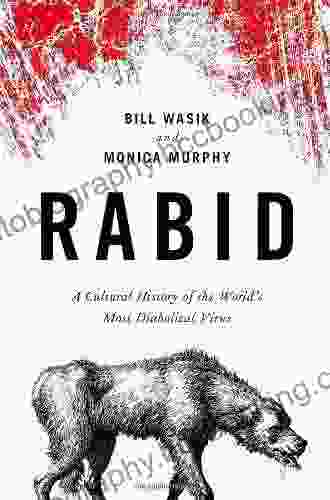Cultural History of the World's Most Diabolical Virus

4.3 out of 5
| Language | : | English |
| File size | : | 5175 KB |
| Text-to-Speech | : | Enabled |
| Screen Reader | : | Supported |
| Enhanced typesetting | : | Enabled |
| Word Wise | : | Enabled |
| Print length | : | 287 pages |
In the annals of human history, the emergence and impact of infectious diseases have left an indelible mark on our societies and cultures. One such virus, renowned for its devastating consequences, has captivated the imaginations of artists, writers, and scholars alike. Through its sinister presence, it has shaped the very fabric of our civilizations, leaving behind a legacy that continues to reverberate today.
Artistic Expressions: A Canvas of Terror and Resilience
In the realm of art, the virus has served as a potent muse, inspiring countless works that explore its destructive power and the resilience of the human spirit. Paintings, sculptures, and installations have captured the grotesque forms of the virus, its relentless spread, and its devastating effects on individuals and communities. These artistic expressions serve as a poignant reminder of the fragility of human life and the indomitable will to survive.

Literary Explorations: Tales of Horror, Survival, and Redemption
Literature has also grappled with the profound themes surrounding the virus. Novels, short stories, and plays have delved into the psychological and societal consequences of the pandemic, exploring the depths of human suffering, courage, and hope. These literary works have become invaluable chronicles of our collective experience, providing insights into the resilience of the human spirit in the face of adversity.
In Emily St. John Mandel's acclaimed novel "Station Eleven," the aftermath of a devastating pandemic is vividly depicted through the lives of survivors who struggle to rebuild a semblance of society. "The Plague" by Albert Camus is a philosophical masterpiece that explores the existential dilemmas faced by individuals amidst a deadly epidemic.
Social Transformations: Reshaping Beliefs and Values
The presence of the virus has not only impacted art and literature but has also profoundly shaped societies and cultures. Throughout history, pandemics have led to shifts in beliefs, values, and social norms. Fear and uncertainty have often given rise to superstition, scapegoating, and social unrest. However, they have also fostered innovation, solidarity, and a renewed appreciation for life.
In the 14th century, the Black Death decimated Europe, leading to a widespread loss of faith in religious institutions and a re-evaluation of traditional values. In more recent times, the HIV/AIDS pandemic has spurred significant advancements in medical research and raised awareness about issues of discrimination and social justice.
The Legacy: A Cautionary Tale and a Call to Action
The cultural history of the virus serves as a cautionary tale, reminding us of the devastating consequences of infectious diseases and the importance of preparedness. It also highlights the resilience and adaptability of humanity, our capacity for compassion, and our collective responsibility to address global health crises. By understanding the cultural footprints of the virus, we can better appreciate its profound impact and work towards creating a more equitable and resilient world.
As we navigate ongoing and future pandemics, the cultural legacy of this enigmatic virus can guide us in confronting the challenges ahead. It reminds us to invest in scientific research, foster global cooperation, and prioritize the well-being of all members of society. By embracing the lessons from the past, we can work together to mitigate the impact of future pandemics and build a more sustainable and compassionate future for generations to come.
4.3 out of 5
| Language | : | English |
| File size | : | 5175 KB |
| Text-to-Speech | : | Enabled |
| Screen Reader | : | Supported |
| Enhanced typesetting | : | Enabled |
| Word Wise | : | Enabled |
| Print length | : | 287 pages |
Do you want to contribute by writing guest posts on this blog?
Please contact us and send us a resume of previous articles that you have written.
 Book
Book Novel
Novel Page
Page Chapter
Chapter Text
Text Story
Story Genre
Genre Reader
Reader Library
Library Paperback
Paperback E-book
E-book Magazine
Magazine Newspaper
Newspaper Paragraph
Paragraph Sentence
Sentence Bookmark
Bookmark Shelf
Shelf Glossary
Glossary Bibliography
Bibliography Foreword
Foreword Preface
Preface Synopsis
Synopsis Annotation
Annotation Footnote
Footnote Manuscript
Manuscript Scroll
Scroll Codex
Codex Tome
Tome Bestseller
Bestseller Classics
Classics Library card
Library card Narrative
Narrative Biography
Biography Autobiography
Autobiography Memoir
Memoir Reference
Reference Encyclopedia
Encyclopedia Blaine Lamb
Blaine Lamb Barbara Raue
Barbara Raue Bobby Blair
Bobby Blair Bil Johnson
Bil Johnson Betty Lauer
Betty Lauer Bill Davis
Bill Davis Bill Patton
Bill Patton Bradley Wiggins
Bradley Wiggins Betsy Maestro
Betsy Maestro Bill White
Bill White Bill High
Bill High Blandine Calais Germain
Blandine Calais Germain Ben Greenfield
Ben Greenfield Ben Swanepoel
Ben Swanepoel Bobby Brown
Bobby Brown Brenda Gable
Brenda Gable Boluwatito Balogun
Boluwatito Balogun Brenda Cooper
Brenda Cooper Breanna Lam
Breanna Lam Beth Tompkins Bates
Beth Tompkins Bates
Light bulbAdvertise smarter! Our strategic ad space ensures maximum exposure. Reserve your spot today!

 Guillermo BlairTips, Techniques, and Step-by-Step Lessons for Learning to Paint Whimsical
Guillermo BlairTips, Techniques, and Step-by-Step Lessons for Learning to Paint Whimsical
 Leo MitchellNclex Style Review Davis Success: Unlocking the Gateway to Nursing Excellence
Leo MitchellNclex Style Review Davis Success: Unlocking the Gateway to Nursing Excellence Pat MitchellFollow ·4.8k
Pat MitchellFollow ·4.8k Gabriel HayesFollow ·19.5k
Gabriel HayesFollow ·19.5k Devin RossFollow ·13.4k
Devin RossFollow ·13.4k Louis HayesFollow ·5.3k
Louis HayesFollow ·5.3k Felix CarterFollow ·17.8k
Felix CarterFollow ·17.8k Marvin HayesFollow ·13.4k
Marvin HayesFollow ·13.4k Noah BlairFollow ·3.1k
Noah BlairFollow ·3.1k Ashton ReedFollow ·7.5k
Ashton ReedFollow ·7.5k

 Alex Foster
Alex FosterRediscover the Old Testament with a Captivating Graphic...
Prepare to embark on an extraordinary...

 Ross Nelson
Ross NelsonThe Christmas Story: The Brick Bible for Kids
LEGO® Bricks Meet the...

 Anton Chekhov
Anton ChekhovUnveiling the Hidden History: The Brick Chronicle of...
In the annals of American history, the...

 Blake Bell
Blake BellOptions Trading Crash Course: A Comprehensive Guide to...
In the fast-paced and...

 Percy Bysshe Shelley
Percy Bysshe ShelleyUnlock Your Artistic Potential with "The Practical...
The Indispensable Handbook for...
4.3 out of 5
| Language | : | English |
| File size | : | 5175 KB |
| Text-to-Speech | : | Enabled |
| Screen Reader | : | Supported |
| Enhanced typesetting | : | Enabled |
| Word Wise | : | Enabled |
| Print length | : | 287 pages |









